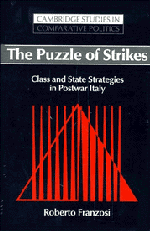Book contents
- Frontmatter
- Contents
- List of tables, figures, and equations
- Dedication
- Preface
- Acknowledgments
- 1 The puzzle box
- 2 Labor-market conditions and bargaining power
- 3 When do workers strike? How the economy matters
- 4 Organizational resources and collective action
- 5 The structure of collective bargaining
- 6 Class power, politics, and conflict
- 7 Mobilization processes: the 1969 autunno caldo
- 8 Countermobilization processes: reactions by the state and employers to strike waves
- 9 The picture in the puzzle
- Epilogue
- Appendix: the data
- Notes
- Bibliography
- Index
9 - The picture in the puzzle
Published online by Cambridge University Press: 08 January 2010
- Frontmatter
- Contents
- List of tables, figures, and equations
- Dedication
- Preface
- Acknowledgments
- 1 The puzzle box
- 2 Labor-market conditions and bargaining power
- 3 When do workers strike? How the economy matters
- 4 Organizational resources and collective action
- 5 The structure of collective bargaining
- 6 Class power, politics, and conflict
- 7 Mobilization processes: the 1969 autunno caldo
- 8 Countermobilization processes: reactions by the state and employers to strike waves
- 9 The picture in the puzzle
- Epilogue
- Appendix: the data
- Notes
- Bibliography
- Index
Summary
The organisation arises as product of the struggle … organisations … are … born from the mass strike … from the whirlwind and the storm, out of the fire and glow of the mass strike and the street fighting rise again, like Venus from the foam, fresh, young, powerful, buoyant trade unions. … In the midst of the struggle the work of organisation is being more widely extended.
Rosa Luxemburg (1971, pp. 64, 36, 38)Class struggle, which is itself structurally limited and selected by various social structures, simultaneously reshapes those structures. … Class struggle is intrinsically a process of transformation of structures, and thus the very process which sets limits on class struggle is at the same time transformed by the struggles so limited. … Organizational capacities are objects of class struggle. … The organizational capacity of the working class to engage in struggle is itself transformed by class struggle.
Wright (1979, pp. 21, 105)In history, as elsewhere, the causes cannot be assumed. They are to be looked for.
Bloch (1953,p. 197)UNEXPECTED FINDINGS, ONE MORE TIME: CLASS CONFLICT AS THE INDEPENDENTVARIABLE
Just when we thought that we had it all wrapped up, with a pat solution for the temporal dynamics of Italian strikes in the postwar period, the reversal of the causal reading at the end of Chapter 8 (strikes as the cause, rather than the effect, of economic, organizational, institutional, and political factors) has brought in a new twist.
- Type
- Chapter
- Information
- The Puzzle of StrikesClass and State Strategies in Postwar Italy, pp. 343 - 377Publisher: Cambridge University PressPrint publication year: 1995

